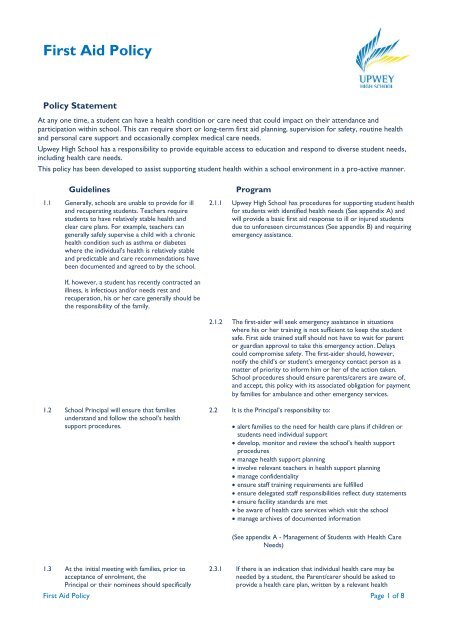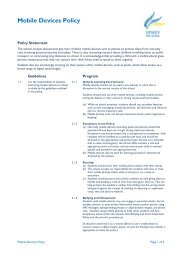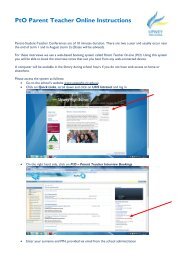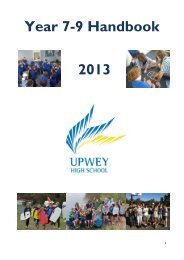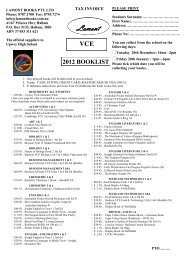First Aid Policy - Upwey High School
First Aid Policy - Upwey High School
First Aid Policy - Upwey High School
You also want an ePaper? Increase the reach of your titles
YUMPU automatically turns print PDFs into web optimized ePapers that Google loves.
<strong>First</strong> <strong>Aid</strong> <strong>Policy</strong><br />
<strong>Policy</strong> Statement<br />
At any one time, a student can have a health condition or care need that could impact on their attendance and<br />
participation within school. This can require short or long-term first aid planning, supervision for safety, routine health<br />
and personal care support and occasionally complex medical care needs.<br />
<strong>Upwey</strong> <strong>High</strong> <strong>School</strong> has a responsibility to provide equitable access to education and respond to diverse student needs,<br />
including health care needs.<br />
This policy has been developed to assist supporting student health within a school environment in a pro-active manner.<br />
Guidelines<br />
1.1 Generally, schools are unable to provide for ill<br />
and recuperating students. Teachers require<br />
students to have relatively stable health and<br />
clear care plans. For example, teachers can<br />
generally safely supervise a child with a chronic<br />
health condition such as asthma or diabetes<br />
where the individual’s health is relatively stable<br />
and predictable and care recommendations have<br />
been documented and agreed to by the school.<br />
Program<br />
2.1.1 <strong>Upwey</strong> <strong>High</strong> <strong>School</strong> has procedures for supporting student health<br />
for students with identified health needs (See appendix A) and<br />
will provide a basic first aid response to ill or injured students<br />
due to unforeseen circumstances (See appendix B) and requiring<br />
emergency assistance.<br />
If, however, a student has recently contracted an<br />
illness, is infectious and/or needs rest and<br />
recuperation, his or her care generally should be<br />
the responsibility of the family.<br />
2.1.2 The first-aider will seek emergency assistance in situations<br />
where his or her training is not sufficient to keep the student<br />
safe. <strong>First</strong> aide trained staff should not have to wait for parent<br />
or guardian approval to take this emergency action. Delays<br />
could compromise safety. The first-aider should, however,<br />
notify the child’s or student’s emergency contact person as a<br />
matter of priority to inform him or her of the action taken.<br />
<strong>School</strong> procedures should ensure parents/carers are aware of,<br />
and accept, this policy with its associated obligation for payment<br />
by families for ambulance and other emergency services.<br />
1.2 <strong>School</strong> Principal will ensure that families<br />
understand and follow the school’s health<br />
support procedures.<br />
2.2 It is the Principal’s responsibility to:<br />
alert families to the need for health care plans if children or<br />
students need individual support<br />
develop, monitor and review the school’s health support<br />
procedures<br />
manage health support planning<br />
involve relevant teachers in health support planning<br />
manage confidentiality<br />
ensure staff training requirements are fulfilled<br />
ensure delegated staff responsibilities reflect duty statements<br />
ensure facility standards are met<br />
be aware of health care services which visit the school<br />
manage archives of documented information<br />
(See appendix A - Management of Students with Health Care<br />
Needs)<br />
1.3 At the initial meeting with families, prior to<br />
acceptance of enrolment, the<br />
Principal or their nominees should specifically<br />
2.3.1 If there is an indication that individual health care may be<br />
needed by a student, the Parent/carer should be asked to<br />
provide a health care plan, written by a relevant health<br />
<strong>First</strong> <strong>Aid</strong> <strong>Policy</strong> Page 1 of 8
<strong>First</strong> <strong>Aid</strong> <strong>Policy</strong><br />
Guidelines<br />
ask whether a child or student has any individual<br />
emergency or routine health and personal care<br />
support needs, for example: predictable<br />
emergency first aid associated with, for example,<br />
anaphylaxis (severe, life threatening allergy),<br />
seizure management or diabetes routine<br />
supervision for health care safety, such as<br />
supervision of Medication personal care,<br />
including assistance with personal hygiene,<br />
continence care, eating and drinking transfers<br />
and positioning, and use of health related<br />
equipment.<br />
1.4 Parents/carers will support the school program<br />
in providing for their child/ren’s wellbeing.<br />
Program<br />
professional. The care plan should document recommended<br />
emergency and routine health and personal care support for<br />
the child or student. Information about medical conditions<br />
(such as asthma, epilepsy and incontinence) must be provided<br />
by a doctor or, in some cases, a clinical nurse consultant<br />
working under the direction of a doctor. A therapist (for<br />
example, a physiotherapist or a speech pathologist) will usually<br />
document information about therapeutic such as transfers and<br />
positioning, and mealtime assistance.<br />
2.3.2 Some students will have a health care need identified after<br />
enrolment. The same steps should be followed. An interim<br />
health support plan might be needed.<br />
2.4. It is the responsibility of parents/carers to:<br />
provide relevant health care information to the school<br />
liaise with health professionals to provide care plans<br />
which create minimum disruption to learning<br />
programs<br />
assist children or students for whom they are<br />
responsible to self manage, as much as is safe and<br />
practical, their health and personal care needs.<br />
(See appendix A - Management of Students with Health Care<br />
Needs)<br />
1.5 The school principal will ensure that allocation<br />
of staff duties anticipates predictable short and<br />
long-term health support needs of children and<br />
students in their care.<br />
2.5 It is reasonable to expect that the school will:<br />
administer first aid for unpredictable illness or injury<br />
coordinate provision of first aid, including monitoring<br />
of equipment and facilities<br />
administer additional, individual first aid support as<br />
negotiated (for example, administration of adrenalin<br />
via Epi-Pen for anaphylaxis).<br />
Note-Invasive emergency care (such as administration of rectal<br />
diazepam for seizure management) is not a standard first aid<br />
procedure and so requires the involvement of a registered<br />
nurse.<br />
(See appendix B - <strong>First</strong> <strong>Aid</strong> Care Procedures)<br />
1.6 <strong>First</strong> <strong>Aid</strong> support in the school will be provided<br />
in response to unpredictable illness or injury.<br />
2.6 The school will have a number of teachers and Educational<br />
Support staff trained in first aid able to treat unpredictable<br />
illness or injury.<br />
One member of staff will be delegated the task of coordinating<br />
first aid procedures, supervising the first aid facility and<br />
maintaining and securing the contents of the school’s first aid<br />
kit. A relief staff member will be nominated in the event of the<br />
absence of the first aid coordinator. Other staff with first aid<br />
qualifications will be identified and available to assist.<br />
(See appendix B - <strong>First</strong> <strong>Aid</strong> Care Procedures)<br />
<strong>First</strong> <strong>Aid</strong> <strong>Policy</strong> Page 2 of 8
<strong>First</strong> <strong>Aid</strong> <strong>Policy</strong><br />
Links<br />
http://www.education.vic.gov.au/hr/ohs/health/firstaid.htm<br />
http://www.education.vic.gov.au/hr/ohs/hazards/<strong>First</strong>aid.htm<br />
https://www.eduweb.vic.gov.au/edulibrary/<strong>School</strong>s/Forms/General%20<strong>School</strong>%20Forms/student%20health%20support%2<br />
0plan%20template-frm-v1.0-may%202008.doc<br />
http://www.education.vic.gov.au/healthwellbeing/health/anaphylaxis.htm<br />
https://www.eduweb.vic.gov.au/edulibrary/<strong>School</strong>s/Forms/General%20<strong>School</strong>%20Forms/medication%20authority%20for<br />
m-frm-v1.0-may%202008.doc<br />
https://www.eduweb.vic.gov.au/edulibrary/<strong>School</strong>s/Forms/General%20<strong>School</strong>%20Forms/medication%20administration%2<br />
0log-tmp-v1.0-may%202008.doc<br />
https://www.eduweb.vic.gov.au/edulibrary/<strong>School</strong>s/Forms/General%20<strong>School</strong>%20Forms/general%20medical%20advice%2<br />
0form-frm-v1.0-may%202008.doc<br />
http://www.asthma.org.au/Default.aspxtabid=102<br />
http://www.education.vic.gov.au/healthwellbeing/health/anaphylaxis.htm<br />
Appendix A - Managing Students with Special Health Needs<br />
Appendix B - <strong>First</strong> <strong>Aid</strong> Care Procedures<br />
Evaluation<br />
This policy will be reviewed as part of the school’s 3 year cycle or as required by developments in relevant legislation.<br />
<strong>Policy</strong> drafted by:<br />
Education Committee<br />
Date ratified by school council: 28 October 2009<br />
<strong>First</strong> <strong>Aid</strong> <strong>Policy</strong> Page 3 of 8
<strong>First</strong> <strong>Aid</strong> <strong>Policy</strong><br />
Appendix A - Managing Students with Special Health Needs<br />
Any information provided to the school on the enrolment form or separately will be taken into account<br />
when planning the care of a student. Where students have a health care need identified after enrolment,<br />
the same steps will be followed.<br />
1. When a need is identified<br />
Parents/carers are required to provide accurate information about a student’s routine health and personal<br />
care support needs, and emergency care needs, for example:<br />
• predictable emergency first aid associated with an allergic reaction, seizure management, anaphylaxis, or<br />
diabetes<br />
• routine supervision for health care safety, such as supervision of medication<br />
• personal care, including assistance with personal hygiene, continence care, eating and drinking, transfers<br />
and positioning, and use of health-related equipment.<br />
Parents/carers and students will be informed when their information is being collected about how their<br />
personal information will be used and to whom it might be disclosed. For example, to school nurses, who<br />
will require access to relevant student information in order to provide appropriate services too.<br />
Medical advice is required from the student’s medical/health practitioner if there is an indication that a<br />
student has a health care need. The medical advice received must provide relevant information about the<br />
student’s medical condition and document recommended emergency and routine health and personal care<br />
support for the student. Ideally medical advice should be sought via the completion of a relevant Medical<br />
Advice Form.<br />
For any student requiring medication whilst at school, the school must receive written directions ideally<br />
from the student’s medical/health practitioner. This can be done so via the completion of a Medication<br />
Authority Form or ASCIA Action Plan for anaphylaxis or <strong>School</strong> Asthma Action Plan for asthma (see<br />
Victorian Government <strong>School</strong>s Reference Guide 4.5.3.1).<br />
Information about the student’s health condition as well as medication to be stored and supervised at<br />
school should be loaded in Cases21 Database.<br />
The development of a Student Health Support Plan (see Victorian Government <strong>School</strong>s Reference Guide<br />
4.5.3.1) (or in the case of Anaphylaxis an Anaphylaxis Management Plan (see 4.5.10.2)) will occur after the<br />
school has received the appropriate medical advice from the student’s medical/health practitioner. If there<br />
is a time delay between receiving this advice and in the development of a Student Health Support Plan, the<br />
school may decide to put in place an interim support plan outlining an agreed interim strategy, e.g. call an<br />
ambulance immediately.<br />
Plans should be developed when a student is to attend school excursions and camps. The parent/carer<br />
should complete a Confidential Medical Information for <strong>School</strong> Council Approved <strong>School</strong> Excursion<br />
(4.4.2.5).<br />
<strong>First</strong> <strong>Aid</strong> <strong>Policy</strong> Page 4 of 8
<strong>First</strong> <strong>Aid</strong> <strong>Policy</strong><br />
2. The planning process<br />
The Principal (or nominee) should organise a meeting to negotiate the development of a Student Health<br />
Support Plan (see 4.5.3.1) (or in the case of Anaphylaxis an Anaphylaxis Management Plan (see 4.5.10.2))<br />
with the student, student’s parents/carers and other relevant school staff. This Support Plan should be<br />
guided by the medical advice received by the student’s medical/health practitioner.<br />
A range of questions may be asked in planning support. For example:<br />
• Is it necessary to provide the support during the school day<br />
• How can the recommended support be provided in the simplest manner, with minimal interruption to the<br />
education and care program<br />
• Who should provide the support<br />
• Is this support complex and/or invasive<br />
• Is there staff training required<br />
• Are there any facilities issues that need to be addressed<br />
• How can the support be provided in a way that respects dignity, privacy, comfort and safety and enhances<br />
learning<br />
• Are there any care and learning plans that should be completed for students with personal care support<br />
3. Monitoring and review<br />
• A date for when medical advice received by the student’s medical/health practitioner is to be reviewed<br />
(generally within twelve months) will be set.<br />
• Student Health Support Plans (see 4.5.3.1) (or in the case of Anaphylaxis an Anaphylaxis Management<br />
Plan (see 4.5.10.2)) will be annually reviewed in light of the updated information received by the<br />
student’s medical/health practitioner. Student Health Support Plans will be reviewed earlier if the<br />
school or the student’s parents/carers have concerns or if there is any change in the support.<br />
• It may be agreed that an annual review of the Student Health Support Plan may not require updated<br />
medical advice. It is up to the principal’s discretion to request updated medical advice for a student.<br />
<strong>First</strong> <strong>Aid</strong> <strong>Policy</strong> Page 5 of 8
<strong>First</strong> <strong>Aid</strong> <strong>Policy</strong><br />
Appendix B – <strong>First</strong> <strong>Aid</strong> Care Procedures<br />
1.0 Introduction<br />
The school has procedures for supporting student health for students with identified health needs (See appendix -a) and<br />
will provide a basic first aid response as set out in the procedure below to ill or injured students due to unforeseen<br />
circumstances and requiring emergency assistance.<br />
These procedures have been communicated to all staff and are available for reference from the <strong>School</strong> Office.<br />
2.0 <strong>First</strong> <strong>Aid</strong> Officers<br />
Consistent with the Department’s <strong>First</strong> <strong>Aid</strong> <strong>Policy</strong> and Procedures, the school has allocated staff member/s as its <strong>First</strong><br />
<strong>Aid</strong> Officer/s.<br />
2.1 <strong>First</strong> <strong>Aid</strong> Officer Duties<br />
The <strong>First</strong> <strong>Aid</strong> Officer/s is required to undertake a coordinating role maintaining standard of medical service provision,<br />
student medical records and parent notifications. Their specific duties include:<br />
<br />
<br />
<br />
<br />
<br />
<br />
Participating in the risk management process within the school as part of the school’s OHS team. This<br />
may include contributing to risk management solutions and providing feedback on injury reports and first<br />
aid register data to identify persistent or serious hazards.<br />
Providing first aid emergency awareness training for staff including emergency notification processes, a<br />
list of responsible officers and provision of emergency phone numbers.<br />
Coordinating first aid duty rosters and maintaining first aid room and first aid kits<br />
Providing first aid services commensurate with competency and training. This may include all or some of<br />
emergency life support including response to life threatening conditions which may occur in the school<br />
(E.g. cardiac arrest or respiratory difficulties associated with asthma), management of severe bleeding,<br />
basic wound care, fractures, soft tissue injury.<br />
Recording all first aid treatment. A copy of treatment provided shall be forwarded with the patient<br />
where further assistance is sought. The first aider should respect the confidential nature of any<br />
information given.<br />
Providing input on first aid requirements for excursions and camps.<br />
The <strong>First</strong> <strong>Aid</strong> Officer/s will be available at the school during normal working hours and at other times when authorised<br />
Department programs are being conducted.<br />
Where possible, only staff with first aid qualifications will provide first aid. However, in an emergency other staff<br />
may be required to help within their level of competency.<br />
3.0 Procedures for Medical Treatment<br />
In the event of a student requiring medical attention, an attempt will be made to contact the parents/guardians before<br />
calling for medical attention except in an extreme emergency.<br />
In serious cases, parents/guardians will always be informed as quickly as possible of their child’s condition and of the<br />
actions taken by the school.<br />
All accidents and injuries will be recorded on the Department’s injury management system on CASES21.<br />
A Record of <strong>First</strong> <strong>Aid</strong> Treatment will be kept in the Sick Bay and information recorded for all students treated in the<br />
Sick Bay. A pink slip will be filled in and sent home with the student indicating date and time of attendance in the Sick<br />
Bay, the treatment given and the person administering the first aid.<br />
It is the policy of the school that all injuries to the head are reported to Principal Team Member in charge of <strong>First</strong> <strong>Aid</strong><br />
and that parents/emergency contacts are contacted regarding the injury.<br />
<strong>First</strong> aid kits will be available for all groups that leave the school on excursions. The content of these kits will be<br />
dependent on the nature of the activities, the number of students and staff, and the location of the excursion.<br />
Portable first aid kits will be available for staff on yard duty. These kits will contain:<br />
<strong>First</strong> <strong>Aid</strong> <strong>Policy</strong> Page 6 of 8
<strong>First</strong> <strong>Aid</strong> <strong>Policy</strong><br />
<br />
<br />
<br />
<br />
<br />
a pair of single use plastic gloves<br />
a bottle of sterile eye solution<br />
gauze and band-aids<br />
Record book & pen<br />
<strong>First</strong> <strong>Aid</strong> passes<br />
4.0 Assessment and <strong>First</strong> <strong>Aid</strong> Treatment of an Asthma Attack<br />
If a student develops signs of what appears to be an asthma attack, appropriate care must be given immediately.<br />
Assessing the severity of an asthma attack<br />
Asthma attacks can be:<br />
<br />
<br />
<br />
Mild - this may involve coughing, a soft wheeze, minor difficulty in breathing and no difficulty speaking in<br />
sentences<br />
Moderate - this may involve a persistent cough, loud wheeze, obvious difficulty in breathing and ability to<br />
speak only in short sentences<br />
Severe - the student is often very distressed and anxious, gasping for breath, unable to speak more than a few<br />
words, pale and sweaty and may have blue lips.<br />
All students judged to be having a severe asthma attack require emergency medical assistance.<br />
Call an ambulance (dial 000), notify the student’s emergency contact and follow the ‘4 Step Asthma <strong>First</strong> <strong>Aid</strong> Plan’ while<br />
waiting for the ambulance to arrive. When calling the ambulance state clearly that a student is having ‘breathing<br />
difficulties.’ The ambulance service will give priority to a person suffering extreme shortness of breath. Regardless of<br />
whether an attack of asthma has been assessed as mild, moderate or severe, Asthma <strong>First</strong> <strong>Aid</strong> (as detailed below)<br />
must commence immediately. The danger in any asthma situation is delay. Delay may increase the severity of the<br />
attack and ultimately risk the student’s life.<br />
Asthma <strong>First</strong> <strong>Aid</strong><br />
If the student has an Asthma Action Plan follow the first aid procedure immediately. If no Asthma Action Plan is<br />
available the steps outlined below should be taken immediately.<br />
The 4 Step Asthma <strong>First</strong> <strong>Aid</strong> Plan (displayed in Sick Bay and classrooms)<br />
Step 1<br />
Sit the student down in as quiet an atmosphere as possible. Breathing is easier sitting rather than lying down. Be calm<br />
and reassuring. Do not leave the student alone.<br />
Step 2<br />
Without delay give 4 separate puffs of a blue reliever medication (Airomir, Asmol, Epaq or Ventolin). The medication is<br />
best given one puff at a time via a spacer device. If a spacer device is not available, simply use the puffer on its own.<br />
Ask the person to take 4 breaths from the spacer after each puff of medication.<br />
Step 3<br />
Wait 4 minutes. If there is little or no improvement repeat steps 2 and 3.<br />
Step 4<br />
If there is still little or no improvement; call an ambulance immediately (dial 000). State clearly that a student is having<br />
‘breathing difficulties.’<br />
Continuously repeat steps 2 and 3 while waiting for the ambulance.<br />
<strong>First</strong> <strong>Aid</strong> <strong>Policy</strong> Page 7 of 8
<strong>First</strong> <strong>Aid</strong> <strong>Policy</strong><br />
5.0 <strong>First</strong> <strong>Aid</strong> Kit Contents<br />
Consistent with the Department’s <strong>First</strong> <strong>Aid</strong> <strong>Policy</strong> and Procedures the school will maintain a <strong>First</strong> <strong>Aid</strong> Kit that includes<br />
the following items:<br />
an up-to-date first aid book. Examples include:<br />
- <strong>First</strong> aid: Responding to Emergencies, Australian Red Cross ;<br />
- Australian <strong>First</strong> <strong>Aid</strong>, St John Ambulance Australia (current edition);<br />
<br />
- Staying Alive, St John Ambulance Australia, (current edition).<br />
wound cleaning equipment<br />
– gauze swabs: 100 of 7.5 cm x 7.5 cm divided into small individual packets of five<br />
– sterile saline ampoules: 12 x 15 ml and 12 x 30 ml<br />
– disposable towels for cleaning dirt from skin surrounding a wound<br />
wound dressing equipment<br />
– sterile, non-adhesive dressings, individually packed: eight 5 cm x 5 cm, four 7.5 m x 7.5 m, four 10 cm x 10 cm for larger<br />
wounds<br />
– combine pads: twelve 10 cm x 10 cm for bleeding wounds<br />
– non-allergenic plain adhesive strips, without antiseptic on the dressing, for smaller cuts and grazes<br />
– steri-strips for holding deep cuts together in preparation for stitching<br />
– non-allergenic paper type tape, width 2.5 cm–5 cm, for attaching dressings<br />
– conforming bandages for attaching dressings in the absence of tape or in the case of extremely sensitive skin<br />
– six sterile eye pads, individually packed<br />
bandages<br />
– four triangular bandages, for slings, pads for bleeding or attaching dressings, splints etc<br />
– conforming bandages: two of 2.5 cm, two of 5 cm, six of 7.5 cm and two of 10 cm. These may be used to hold dressings in<br />
place or for support in the case of soft tissue injuries<br />
• lotions and ointments<br />
– cuts and abrasions should be cleaned initially under running water followed by deeper and more serious wounds being<br />
cleaned with sterile saline prior to dressing. Antiseptics are not recommended<br />
– any sun screen, with a sun protection factor of approximately 15+<br />
– single use sterile saline ampoules for the irrigation of eyes<br />
– creams and lotions, other than those in aqueous or gel form, are not recommended in the first aid treatment of wounds or<br />
burns<br />
asthma equipment (which should be in all major portable kits, camping kits, sports kits etc)<br />
– blue reliever puffer (e.g. Ventolin) that is in date<br />
– spacer device<br />
– alcohol wipes.<br />
Other equipment includes:<br />
single use gloves. These are essential for all kits and should be available for teachers to carry with them, particularly while on yard duty<br />
blood spill kits<br />
vomit spill kits<br />
one medicine measure for use with prescribed medications<br />
disposable cups<br />
one pair of scissors (medium size)<br />
disposable splinter probes and a sharps container for waste<br />
disposable tweezers<br />
one teaspoon<br />
disposable hand towels<br />
pen-like torch, to measure eye-pupil reaction<br />
two gel packs, kept in the refrigerator, for sprains, strains and bruises or disposable ice packs for portable kits<br />
adhesive sanitary pads, as a backup for personal supplies<br />
flexible ‘sam’ splints for fractured limbs (in case of ambulance delay)<br />
additional 7.5 m conforming bandages and safety pins to attach splints<br />
blanket and sheet, including a thermal accident blanket for portable kits<br />
germicidal soap and nail brush for hand-cleaning only<br />
one box of paper tissues<br />
paper towel for wiping up blood spills in conjunction with blood spill kit<br />
single use plastic rubbish bags that can be sealed, for used swabs and a separate waste disposal bin suitable for taking biohazard waste<br />
(Note: Biohazard waste should be burnt and there are several companies that will handle bulk biohazard waste)<br />
ice cream containers or emesis bags for vomit.<br />
6.0 Emergency Telephone Numbers<br />
Poisons Information Service : 13 11 26<br />
Ambulance 000<br />
<strong>First</strong> <strong>Aid</strong> <strong>Policy</strong> Page 8 of 8


